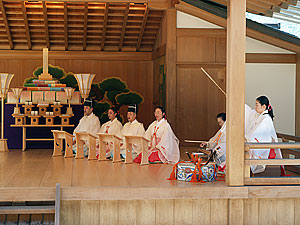
By Bill Roberts
Soon after I arrived in mid-March 2008 for a three-month stay at Oomoto, I had a dream I did not understand until several weeks later, when I found myself trudging up the steep trail on Mount Misen. First a few words about the annual pilgrimage to Mount Misen, and then fewer words about the dream.
Mount Misen is 800 meters high (about 2,600 feet), a sharply tapered cone in the Tamba Mountains, which surround Ayabe, the spiritual headquarters of Oomoto. Ayabe lies sixty kilometers northwest of Kameoka, Oomoto’s educational and administrative center.
Japan has many higher mountains, including Mount Fuji (3,776 meters), which is the highest. Nevertheless, Mount Misen is impressive because it arises from sea level, dwarfing everything nearby and striking a sharp contrast to the surrounding farmland. On a clear day, you can see Mount Misen from the Oomoto burial grounds, which occupy a pine-covered promontory above the Ayabe headquarters.
The Tamba Mountains have traits similar to California’s coastal Santa Lucia Mountains, which include the Big Sur country where I hiked in my youth. The two ranges are about the same height on average. Like the Tambas, the Santa Lucias appear taller than they are because they, too, rise from sea level. Rugged peaks, deep canyons filled with ferns and flowers, swift cold creeks corkscrewing through the terrain tumbling into small waterfalls, and various coniferous and deciduous trees –substitute Tamba cedars for Big Sur redwoods and the two regions could almost be twins.
Whenever I walk in the Tamba range, I feel at home.
Tamba shares another trait with Big Sur country. Unlike higher North American ranges, where trails tend to zigzag upward in long gradual switchbacks, the trails of Big Sur and of Tamba tend to follow a mountain goat’s line of ascent – they go straight up. This is an important factor in my story.
Mount Misen in Oomoto history
Mount Misen played a role in the ancient mythology of Japan and in the early history of Oomoto. First some background. The god Ushitora no Konjin took possession of Foundress Nao Deguchi (1837-1918) of Ayabe in 1892, and through her announced his intent to reconstruct the world. At the urging of other gods, Ushitora had left the world to their management for 3,000 years, but they made such a mess he had to return to put things right.
Oomoto remained small and local until Kisaburo Ueda (1871-1948) joined. In 1898, Ueda underwent spiritual training on Mount Takakuma near Kameoka. Soon after, Ueda and Nao met, and came to understand they were to work together. On New Year’s Day 1900, Ueda married Nao’s youngest daughter, Sumiko, took the name Onisaburo Deguchi, and became Co-Founder. Sumiko (1882-1952) became the Second Spiritual Leader after Nao died. Onisaburo and Sumiko were the great grandparents of the current (the Fifth) Spiritual Leader, Kurenai Deguchi (born 1956). The Spiritual Leader is always a female descendant of Nao on the matrilineal line.
In the early years, there was friction between Nao and Onisaburo, manifesting itself in vociferous exchanges between the spirits that possessed each of them. Early Oomoto followers were astonished to see the spirits take over and argue ferociously because the two leaders were otherwise on good terms.
In October 1901, Nao needed a break from the conflict and secluded herself on Mount Misen, where two kami – or gods – were enshrined since ancient times, one on top and one at a shrine halfway up the mountain. In going there, Nao went where no woman had gone for a long time. Until 1872, women were forbidden by law to climb Mount Misen; after the law was rescinded the local women continued for years to avoid the hill.
Nao went to the shrine halfway up the mountain, and spent a week praying, and writing the “Ofudesaki,” which are the words of Ushitora no Konjin as recorded by Nao through automatic writing. She used a nearby waterfall for her daily ablutions.
After Nao had been there several days a rumor spread among nearby villagers that a baboon had moved into the shrine. Villagers and the local constable hurried up the hill to drive out the squatter, and were upset to find a woman. Nao told the angry crowd that she had completed her week of seclusion and was about to depart. The constable took her into custody anyway and brought her to a police station, where police questioned her.
About this time, Onisaburo returned to Ayabe from Kyoto. He learned what happened and immediately went to the police station. The police wanted to fine Nao for being on the mountain, but Onisaburo knew the 1872 law, and secured her release without paying a fine.
When the spirits that possessed Nao and Onisaburo ceased arguing a couple of years later, Nao, Onisaburo, Sumiko, and Oomoto followers celebrated by holding a service on top of Mount Misen on April 28, 1903. By then, Nao’s automatic writing had revealed that the spirit of her infant granddaughter, Naohi, was the same kami enshrined on the summit. Naohi Deguchi (1902-1990) was the Third Spiritual Leader.
Annual celebration
Each April 28, the Spiritual Leader, priests and dozens of followers commemorate Nao’s second trip to Mount Misen with a service at the summit shrine. The pilgrimage includes a short prayer at the second shrine halfway down the mountain, a third prayer at a shrine at the bottom, and a final prayer at a fourth shrine 10 minutes by car on the road back to Ayabe.
In 2008, the Spiritual Leader performed kencha – “tea offering” -- at both the summit shrine and the second shrine. She prepared a bowl of tea as in tea ceremony, and then a priest placed the bowl on the altar as an offering to the enshrined kami. In 2005, I saw the Spiritual Leader perform kencha on Meshima, the island where Ushitora no Konjin was secluded for 3,000 years. Oomoto has a pilgrimage to the island every five years.
For the Mount Misen kencha, the Spiritual Leader used a tea bowl she had made; it was fired in late March in the wood-burning kiln in Ayabe. The clay for the bowl came from Mount Misen, giving this kencha a beautiful sense of completeness.
Strong legs, weak lungs
Late April, ahead of the summer heat and humidity, is the optimal time to hike to Mount Misen. The foliage is thinner than in summer, when it would more than likely overgrow parts of the narrow trail. In winter the mountain is snowed in for weeks. One member of the Oomoto staff told me about getting lost while hiking to the top in knee-deep snow years ago. His tale reminded me of the time I was caught in a snowstorm in the Santa Lucias four decades ago. The things young men do in the mountains.
The day we climbed Mount Misen the conditions were near perfect – a partly cloudy mid-spring sky with no sign of rain. The air was cool when we began walking at 9 AM. By afternoon, we were drenched in sunlight.
The service on top began at 11 AM, giving us two hours to make the summit. The distance is only 2.2 kilometers, but the trail is very steep. The first half, to the shrine where Nao spent a week, is the easier part; beyond that the trail heads straight up the steep hill for more than a kilometer to a flat oblong spot of about 30 square meters on top. The last stretch has a few flights of stone steps, but is mostly a narrow dirt path. Rain would make it slippery and nearly impassable.
Starting out, I felt strong and anticipated no problems. At 58, I’m overweight and not in great shape, but I still have mountain legs. “I walk fast for a fat man,” I tell Japanese hosts. This day I would struggle. It took me 90 minutes to reach the summit. I started strong, and passed many hikers, only to watch them pass me on the upper section of the trail. About 190 participated and most arrived on top before I did.
For all the praying at the shrines, I prayed more during the hike – imploring all the kami of the mountain to let me arrive without a heart attack. About halfway up the final stretch, my lungs felt ready to explode (on the return trip, my knees wanted to explode). When lungs are about to explode the mind becomes intensely focused; that’s when the dream from weeks earlier entered my thoughts. So now I’ll tell you about the dream.
An epiphany on the slope
I don’t remember many dreams and rarely do they seem important. This one was different. In the dream I could see heaven in the distance; it was on top of a mountain. A trail led to the top, zigzagging back and forth in switchbacks, unlike the trail on Mount Misen. The dream mountain had less vegetation than Mount Misen. Even from a distance, I could see souls on the trail on their way to heaven.
The souls were not climbing by themselves. What I saw was something like kensen, the part of the Oomoto ritual when the priests transport rice and other offerings to the altar in a choreographed movement resembling a minuet. In my dream, Oomoto priests carried the souls up the mountain like food to the altar. Each soul sat on a wooden tray; each priest took the tray from the priest below him, turned and took a few steps and handed the tray to the priest on the trail above him, and then turned around and took the next tray from the priest below him, and so on – just like kensen.
That was the dream. It seemed significant, but I did not know exactly what to make of it. I am a fan of Joseph Campbell (1904-1987), an American scholar of mythology and religion, who once wrote: “Dreams are personal myths.” When I have dreams that seem profound, I try to understand them because I believe some myths, including personal ones, contain important truths. Mountains have long held mythical meaning for me, so when they appear in my dreams I pay close attention.
By “myth” I mean a story about actual or plausible historical events that illustrates, informs and inspires the worldview of a people or explains a practice or belief. Islands and mountains important to Oomoto are associated with plausible ancient events and with actual recorded events from the sect’s early days; they also inspire followers, as seen by the pilgrimages, which are deeply spiritual events for the participants.
Near the top of Mount Misen I had a moment of clarity and understood that my dream was telling me three things: first, that heaven exists; second, that, like the top of Mount Misen, heaven is hard to reach; and third, that help is available. Unlike Mount Misen, where each had to climb for himself, the path to heaven is littered with helpers. Thanks to Mount Misen, my dream took on personally mythical meaning.
Another mountain, another myth
My dream mountain looked nothing like Mount Misen, but it did resemble Mount Hachibuse (1,221 meters), in the Chugoku Mountains, which I also climbed in 2008. In mid-May, the Spiritual Leader leads an annual pilgrimage that starts on Saturday with a service at a shrine in Oozasa, a village on the mountain’s northeastern side, and concludes on Sunday morning with a service at a rock outcropping near the summit.
Today, Mount Hachibuse is a popular winter resort, about a three-hour drive west of Ayabe. A road goes near the summit, leaving a 20-minute hike of 500 to 600 meters from where you park the car. It is steep but there are steps most of the way. Unlike the shrines on Mount Misen, which are buildings, the one near the top of Mount Hachibuse is a simple stone marker. It is not on the summit, but 10 meters below what proved to be a false summit when I scrambled to the top after the service. From the false summit I could see the real summit 100 meters north and 20 meters higher in elevation; I sauntered over to pay respects to the top of two ski lifts.
Where the service is held, there’s barely enough flat terrain in front of the stone shrine for a small altar erected for the event and for the priests to stand; the 250 worshippers stood on the steep slope. The Spiritual Leader also performed kencha on Mount Hachibuse.
Like Mount Misen, Mount Hachibuse has an interesting story behind it. Before she died, Nao told an Oomoto missionary about an important spiritual place in his region – present day Hyogo Prefecture. She was uncertain of its exact location.
In 1920, two years after Nao died, the missionary discovered what he sensed was a powerful stone in Oozasa. He recruited several families for Oomoto from the village; they eventually built a shrine at the stone. In 1945, Oomoto followers from Oozasa discovered the unusual rock outcropping near the summit. In May 1946, on one of his last trips, Onisaburo and Sumiko visited the shrine in the village and the rock near the top.
Onisaburo declared the rock near the summit contained the spirit of the Supreme Creator of the Universe, and the rock in the village contained the spirit of the Princess of the Dragon Palace of the Sea. The princess was the first kami to align with Ushitora no Konjin when he began to reconstruct the world. In so doing, the princess changed from a goddess of greed to a goddess of abundance. For Oomoto, she represents hope for the spiritual age to come.
It is important to note that while Oomoto followers acknowledge the existence of the traditional Shinto gods, and often pray directly to them, they believe that all gods, religions, prophets and messengers come from the same source -- the one Supreme Creator of the Universe. "Oomoto" means "great source," or "great origin."
For Oomoto followers, Mount Hachibuse has great spiritual power, as do Mount Misen, Meshima and other places. Personally, I do not attach the same religious importance to these spots, but I appreciate and respect their deep significance for Oomoto believers. And what I really appreciate about these pilgrimages is the way Oomoto ties its beliefs into the natural world. This aspect of Oomoto resonates with me, and is unlike anything I experienced in western religion.
Mount Hachibuse looked like the mountain in my dream, and the spiritual ardor of the worshippers was special that day. Yet, Mount Misen remains the more important mountain to me personally because that is where I came to understand my dream. As for me and Hachibuse, sometimes a mountain is just a mountain.
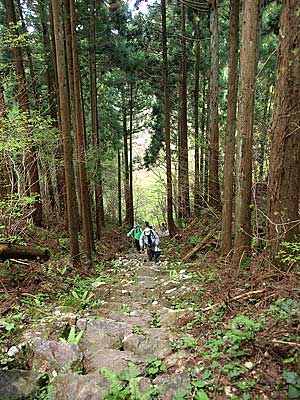
The trail to the top of Mount Misen occasionally includes stone steps.
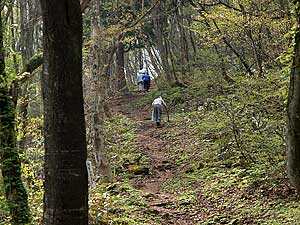
Most of the path is plain dirt.
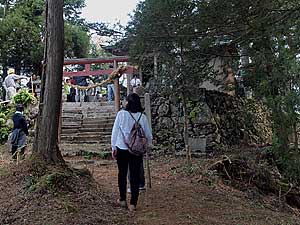
The shrine on top of Mount Misen.
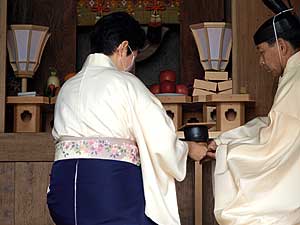
The Spiritual Leader makes a bowl of tea as an offering.
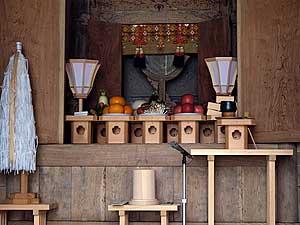
The altar, with the offering of tea.
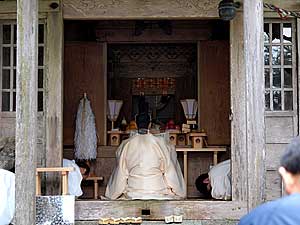
During the service, the chief priest offers a prayer.
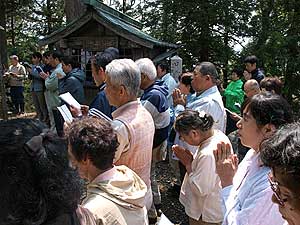
Group prayer on Mount Misen; about 190 people attended.
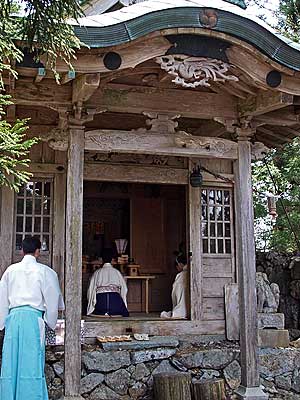
The Spiritual Leader leads the group prayer.
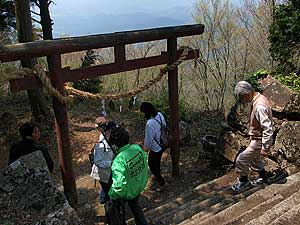
Starting the steep climb down.
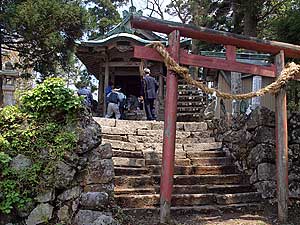
One last look at the summit.
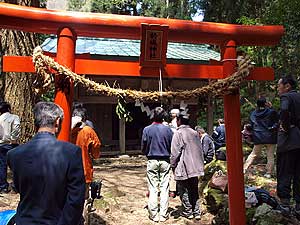
A second prayer service is held at the shrine halfway up the mountain.
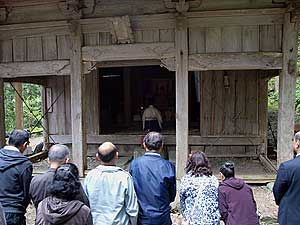
This is the shrine where Nao Deguchi secluded herself for a week in 1901.
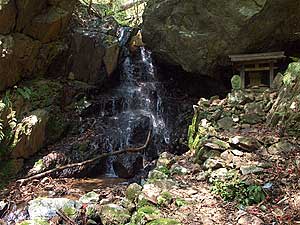
Near the second shrine, the waterfall where Nao took her daily ritual baths.
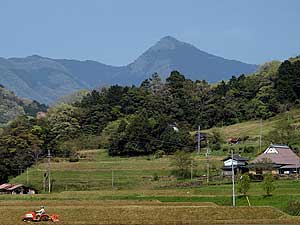
Mount Misen: The halfway shrine is about where the slope starts to get steep on the left hand side.

Mount Hachibuse, the shrine is just below the right-hand peak. The real peak is on the left.
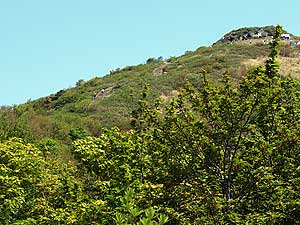
The trail to the Mount Hachibuse shrine.
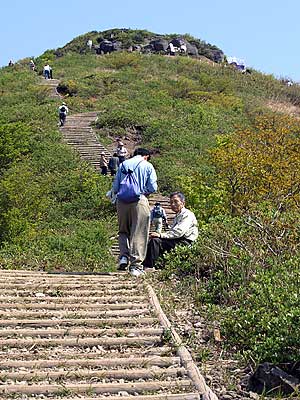
The distance is around 500 meters.
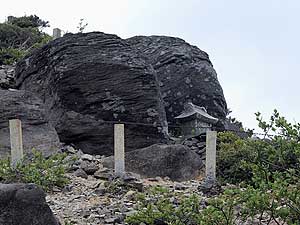
At the top, a simple stone shrine.
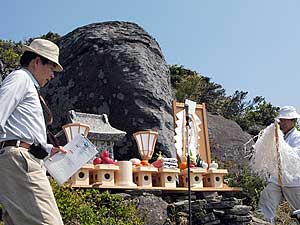
Preparing for the service.

The Spiritual Leader leads prayer.
New Contents Thu, May 20, 2010
- Oomoto participates in Sant’Egidio conference : Dialogue among religions and cultures : On divided island nation of Cyprus By Bill Roberts
- Photo Album : Portraits of three branches: Shoko, Tanegashima and Aomori By Bill Roberts
- Oomoto FAQ
- A Letter from Oomoto : Of mountains and myths By Bill Roberts
- Polyglot poem festival The Utamasturi is going international — what’s next? By Bill Roberts
- Ethics education program captures the spirit of Bankyo Dokon By Bill Roberts
- A Letter from Oomoto : A year’s worth of adventure in a summer of branch visits By Bill Roberts
- In Kumamoto, it’s all about water – and fire By Bill Roberts
- A speech by Nevada Taylor at the Kii Branch in Wakayama Prefecture on April 13, 2008.:An Encounter With Oomoto Through Aikido
- Utamatsuri, Poem Festival, in Tokyo(on April 17, 2008)
- A speech by Neil Ryan Walsh at the Kobe branch on Mar. 9th, 2008.:Planting the Seeds of the Soul
- Meeting with the Fifth Spiritual Leader of Oomoto, Madame Kurenai Deguchi by Neil Ryan Walsh
- A speech by Neil Ryan Walsh at the Nagoya branch on Feb. 17th, 2008.:The Japanese Arts beyond National Boundaries
- To the Oomoto branch in Nagoya: City of Eel and Toyota by Neil Ryan Walsh
- A Speech by Nissim Ben Shitrit, Ambassador of Israel on the occasion of the Oomoto Setsubun Grand Festival in Ayabe February 3rd, 2008 : Japan and Israel : Two Lands Balancing the Needs of Traditional Culture and Modern Life. r
- A permanent memorial to Onisaburo (A Speech at the Autumn Grand Festival , November 6, 2007 : )By James Parks Morton, Founder and Chair, Emeritus of The Interfaith Center of New York
- Israel, Palestine and the Power of Poetry(Oomoto believes small efforts can have lasting ripple effects on people and peace)By Bill Roberts
- “Something Great”(This genetics pioneer, a friend of Oomoto, offers a clue to the mystery of life)By Bill Roberts
- Kamishima Cleanup (Harima branch members regularly visit this sacred island to keep the shrine tidy)By Bill Roberts
- Kyotaro Deguchi was one of six recipients of the 2007 James Parks Morton Interfaith Award
What is Oomoto?
- What is Oomoto?
- Spirtual Centers
- Founders and Spiritual Leaders
- History
- Organization and activities
- Teachings and scriptures
- Art Works of Founders and Leaders
Opinions[Archive]
- Statement of regret for the outbreak of war against Iraq (March 20,2003)
- Jinrui Aizenkai dispatched the "Urgent Appeal for a World (Global) Crisis" on March 14.
Grappling with Bioethics[Archive]
- Oomoto’s support for abolishing the death penalty (12, June 2003)
- The Oomoto Foundation protests any birth of a human clone baby. (5, January 2003)
- OOMOTO'S VIEW REGARDING JAPAN’S PERMITION TO THE RESERCH OF HUMAN EMBRYONIC STEM CELLS (ES cells)(12, June 2000)
Vistor’s Review[Archive]
- A speech by Bill Roberts at the Oomoto branch in Hiroshima after its monthly service on March 18, 2007:Encounters with war and peace
- How Bankyo Dokon changed one life by Linda Macphee
- A speech by Bill Roberts at the Hokuriku (Kanazawa) branch on Dec. 3, 2006:Ritual and myth -an encounter with ‘divine madness’
- A speech by Bill Roberts at the Himeji Cultural Center on Feb. 25, 2007:Mesmerized by the Japanese Arts
- A speech by Bill Roberts at the Kobe branch on Feb. 11th, 2007.:There are just human tears and human joy
- A Speech on the occasion of the Oomoto Setsubun Grand Festival in Ayabe February 3rd, 2007 : Egypt's role in Middle East peace
- Keynote Speech for the 28th World Federation Japanese Religionists Conference for World Peace in Tokyo (at Kokugakuin University, Novermber 29, 2006):Vision for Peace in the Middle East By Dr. Munther S. Dajani, Professor Dean, Faculty of Arts, Al Quds University, Jerusalem
- A speech to the Kyoto branch:Spiritual adventures in researching Oomoto leaders
- A Speech at The Oomoto Foundation on Monday, November 6, 2006 : Jordan's role in Middle East By Samir Nouri, Ambassador of the Hashemite Kingdom of Jordan
- A letter from Oomoto:The Young People of Tottori
- A speech by Bill Roberts on the occasion of the dedication ceremony for the new shrine of Tottori Branch By Bill Roberts Oct. 8, 2006
- A speech by Bill Roberts at the Oomoto branch in Hiroshima after its monthly service on March 18, 2007:Encounters with war and peace
- How Bankyo Dokon changed one life by Linda Macphee
- A speech at Setsubun : A Portrait of Oomoto By Bill Roberts Feb. 3, 2006
- New Publication ! By Bill Roberts Feb. 3, 2006 A Portrait of Oomoto
you can read this book in html => http://www.jinruiaizenkai.jp/English/en-kolumno/en-bill/en-sugao/billbook1en.html
E-mail below to order brobert1@ix.netcom.com
Current Topics
- Prayer Offering and World Religious Forum II
- Living the art of dialogue
- Kyotaro Deguchi was one of six recipients of the 2007 James Parks Morton Interfaith Award
Books
Online Books
- Divine Signposts by Onisaburo DEGUCHI
- The Creation of Meaning by Hidemaru Deguchi
- Bankyo Dokon(Seventy years of Inter-Religious Activity at Oomoto)
- Nao Deguchi — A Biography of the Foundress of Oomoto
- The Great Onisaburo Deguchi published by Aiki News
- Bankyo Dokon Seventy Years of Inter-Religious Activity at Oomoto
- Insearch of Meaning
- Nao Deguchi A Biography of the Foundress of Oomoto
- A Portrait of Oomoto By Bill Roberts
Oomoto international Archive
- The History of Oomoto (Jan.– Mar. 1980 — Apr.– Jun. 1982)
- The Ancestors; Friends or Foes? (Apr.– Jun. 1987)
- Tsukinamisai; The Sabbath of Shinto (Jan.– Jun. 1983)
- The Poem Festival at Oomoto; An Ancient Rite Lives Again (Oct.– Dec. 1981)
- Purification of the Universe ; Oomoto's Setsubun Festival (Apr.– Jun. 1981)
Links
Flowers at Ten'on-kyo & Baisho-en (photographs)
Contact
All rights reserved : the Oomoto Foundation Produced by the Netinformational Commission
Since : Mar. 7.1998 Last Update : Thu, May 20, 2010
E-mail : webmaster@oomoto.or.jp
Top Page Nihongo Esperanto Português Roomazi



